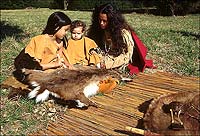Page content
The Native-American Family

American Indian family life was different from and changed by contact with Europeans, who misinterpreted, misconstrued, or simply misunderstood Indian customs. It was ordinary for a European man to be required by the prospective bride’s family to prove his ability to support her, but when an American Indian man presented the bride’s family with skins or other goods, to prove the same thing, Europeans decided that Indian women could be bought. Divorce seems to have been relatively easy, and sexual freedom was not inconsistent with marriage. Problems arose only when the spouse did not approve.
Most Indian cultures were matrilineal and descent was through the mother’s side. Among the Algonquins, a married man had responsibilities to his wife and children and to his mother’s family. Sometimes Indian women inherited positions as tribal rulers.
European men did not understand, nor approve the treatment of American Indian children, on whom affection was lavished, especially by a maternal uncle who undertook their education. Indian children, unlike Europeans, were not spanked or beaten as punishment.
European men did not understand, nor approve the division of labor among American Indian men and women. Women grew crops, erected houses, and did everything related to the home. Men hunted, fished, and made war. Since hunting and fishing were recreational in Europe, Europeans regarded Powhatan men as lazy idlers. In fact, the contribution of both sexes was about equal, until the European demand for hides and furs made the male hunters more important than the female farmers.
That was only one change caused by the European immigration. Europeans brought disease and pushed the Indians off their land, leading to high mortality and low birthrates. As the number of Europeans increased, American Indians were pushed to the edge of extinction. Thomas Jefferson wrote, “there remain of the Mattaponies three or four men only … They have lost their language and have reduced themselves to about fifty acres of Land … The Pamunkies are reduced to about 10 or 12 men … The older ones among them preserved their language in a small degree, which are the last vestiges on earth as far as we know, of the Powhatan language.”
Content excerpted from the Colonial Williamsburg Foundation’s publication “Becoming Americans”.